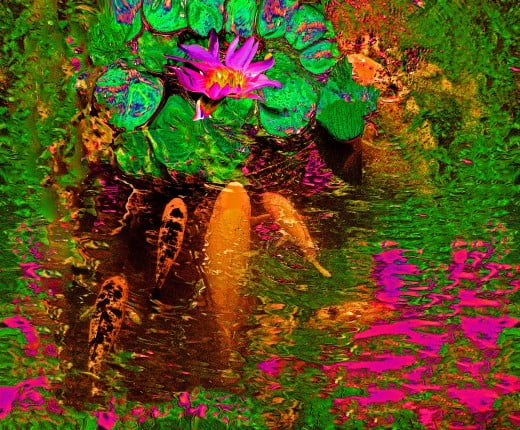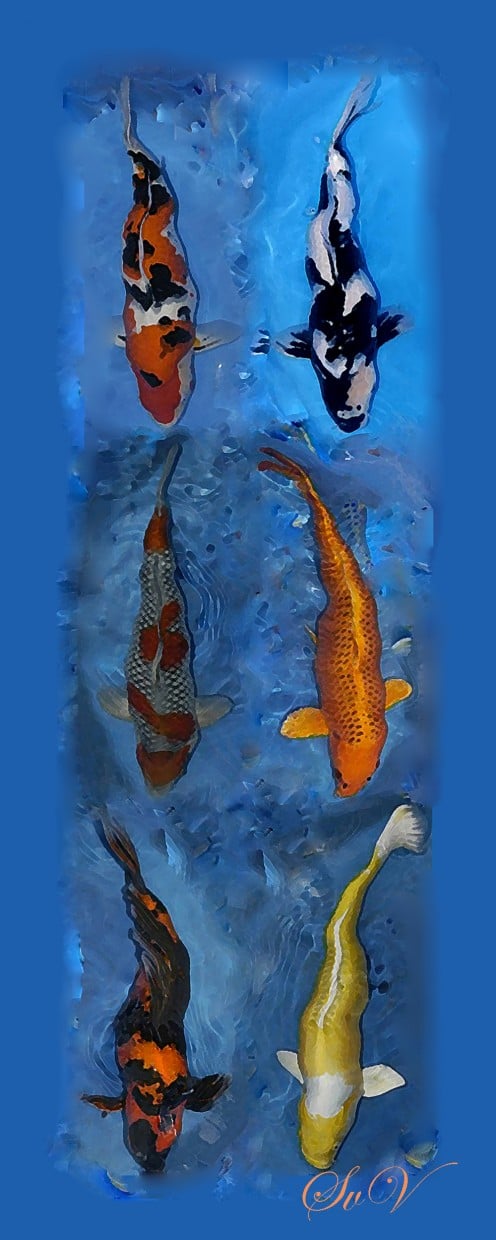Brocaded Koi

Those who dwell among the beauties and mysteries of the earth are never alone or weary of life. ~Rachel Carson
Brocade is 'a class of richly decorative shuttle woven fabrics, often made in colored silks and with or without gold and silver threads'. The name, related to the same root as the word "broccoli", comes from Italian broccato meaning "embossed cloth", or broccare, meaning "to stud, set with nails". Henceforth comes the descriptive name "Brocaded Carp" for the fish Koi. These are fish distinct and characterized with attractive embossed like designs. For this reason they are beloved subject of creative mediums such as art, photography and fashion.

Living Jewels
They are living jewels. Some are priced like artwork, in the thousands of dollars. They are collected, showcased, photographed, painted, and for centuries have served as inspiration for jewelers and sculptors..There is nothing fishy about people's fascination for Koi. Not when you've seen them 'live', swim gracefully with their tattoo-like vivid colors in a Lily pond, or, like me, have actually watched children follow them with their eyes and get all happy. As a photographer it's been a delight for me as well, to savor these natures 'good for the soul' gift, and to capture them as so many artists have done, and still tend to do.
The history of Koi is a mystery. It is believed that the Koi are indigenous to Japan, and in fact, mistaken for “Japanese Goldfish”. There is a difference between the goldfish and Koi. Goldfish and Koi are both selections of carp, but from two different families. Goldfish are mutations from Crucian Carp (Carassius carassius) and Koi are from common carp (Cyprinus carpio).They are believed to originate from eastern Asia, in the Black, Caspian, Aral Seas and China. Carp fossils have been discovered in South China dating as far back as 20 million years ago. The earliest written records of Koi, or Nishikigoi, (Japanese for "brocaded" carp) were first described in writing from a Chinese book written during the Western Chin Dynasty, around 265-316 A.D. At that time they were described as white, red, black and blue.
Koi are descendants of the common carp, Cyprinus Carpio. Originally native to Eastern Europe and Persia, Carp were introduced to Europe, North America, South America, Asia and other areas of the world as a commodity in trade or food. Koi are believed to have been introduced to Japan with the invading Chinese and a first account of them being kept by an emperor in Japan, apparently dates Back to AD 200. Confucius' son, born in 533 B.C., was presented a fish by King Shoko of Ro. The fish were used as the main subject in Chinese artwork and carvings and some Chinese rulers kept carp in captivity for their viewing pleasure. While there may have been natural mutations of carp which featured patches of color on them in China, the Japanese are generally recognized as the creators of Nishikigoi (Living Jewels).
Most people involved in the hobby consider the Niigata prefecture in Japan as the birthplace from which the Nishikigoi sprang. More specifically, areas in and around Ojiya City in Niigata are regarded as the home of Nishikigoi. Today there are more than 100 different color types and sub-types of Koi.
My Kois



Koi Varieties
Koi varieties are distinguished by coloration, patterning, and scalation. Some of the major colors are white, black, red, yellow, blue, and cream. While the possible color variations are virtually limitless, breeders have identified and named a number of specific categories. The most popular category is Gosanke, which is made up of the Kohaku, Taisho Sanshoku, and Showa Sanshoku varieties.
New Koi variaties are still being actively developed. Ghost Koi were developed in the 1980s, and have become very popular in the United Kingdom. There are a hybrid of wild carp and Ogon koi, and are distinguished by their metallic scales. Butterfly Koi, also known as Longfin Koi, or Dragon Carp were also developed in the 1980s, and are notable for their long and flowing fins. They are hybrids of Koi with Asian Carp. Butterfly Koi and Ghost Koi are considered by some to be not true Nishikigoi..
Koi Names




